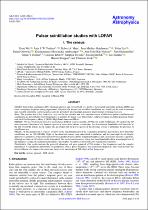| dc.contributor.author | Wu, Ziwei | |
| dc.contributor.author | Verbiest, Joris P. W. | |
| dc.contributor.author | Serylak, Maciej | |
| dc.date.accessioned | 2022-08-19T10:22:53Z | |
| dc.date.available | 2022-08-19T10:22:53Z | |
| dc.date.issued | 2022 | |
| dc.identifier.citation | Wu, Z. et al. (2022). Pulsar scintillation studies with LOFAR I. The census. Astronomy and Astrophysics, 663, A116. https://doi.org/10.1051/0004-6361/202142980 | en_US |
| dc.identifier.issn | 2329-1265 | |
| dc.identifier.uri | https://doi.org/10.1051/0004-6361/202142980 | |
| dc.identifier.uri | http://hdl.handle.net/10566/7753 | |
| dc.description.abstract | Interstellar scintillation (ISS) of pulsar emission can be used both as a probe of the ionized interstellar medium (IISM) and
cause corruptions in pulsar timing experiments. Of particular interest are so-called scintillation arcs which can be used to measure
time-variable interstellar scattering delays directly, potentially allowing high-precision improvements to timing precision.The primary aim of this study is to carry out the first sizeable and self-consistent census of diffractive pulsar scintillation and
scintillation-arc detectability at low frequencies, as a primer for larger-scale IISM studies and pulsar-timing related propagation studies
with the LOw-Frequency ARray (LOFAR) High Band Antennae (HBA). | en_US |
| dc.language.iso | en | en_US |
| dc.publisher | Hans Publishers | en_US |
| dc.subject | Astrophysics | en_US |
| dc.subject | Astronomy | en_US |
| dc.subject | Pulsars | en_US |
| dc.subject | Antenna network | en_US |
| dc.subject | Radio interferometer | en_US |
| dc.title | Pulsar scintillation studies with LOFAR I. The census | en_US |
| dc.type | Article | en_US |

